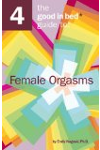Advertisement
A woman’s G-spot is sort of like a prostate. For every part that a man has, a woman has an equivalent part, or homologue. It’s all the same stuff, just organized in a different way. The penis is the homologue of the clitoris, the scrotum is the homologue of the outer labia, and so on. Well, the prostate is the homologue of the urethral sponge, a spongy body of tissue that wraps around the urethra inside a woman’s body. The prostate in men is known to have two functions: It swells up around the man’s urethra when he’s aroused, preventing him from urinating while he’s turned on. It also produces seminal fluid, the whitish liquid in which sperm travel. The urethral sponge, we therefore assume, has the equivalent functions in women. It does, in fact, swell with arousal, closing off the urethra.

More About this Book
The Good in Bed Guide to Female Orgasms
Want to learn how to achieve 487 different kinds of orgasms?If so, you’re reading the wrong guidebook. Despite what many in the media would have you believe, there’s no such thing as a rainbow...
Continue Learning about G-Spot Stimulation
Important: This content reflects information from various individuals and organizations and may offer alternative or opposing points of view. It should not be used for medical advice, diagnosis or treatment. As always, you should consult with your healthcare provider about your specific health needs.
